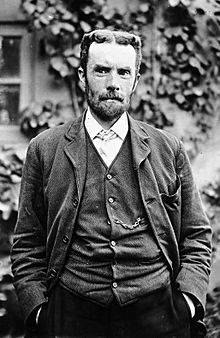Oliver Heaviside facts for kids
Quick facts for kids
Oliver Heaviside
|
|
|---|---|

Heaviside c. 1900
|
|
| Born | 18 May 1850 Camden Town, Middlesex, England
|
| Died | 3 February 1925 (aged 74) |
| Resting place | Paignton cemetery, Devon |
| Nationality | British |
| Known for |
|
| Awards | Faraday Medal (1922) Fellow of the Royal Society |
| Scientific career | |
| Fields | Electrical engineering, mathematics and physics |
| Institutions | Great Northern Telegraph Company |
Oliver Heaviside FRS (18 May 1850 – 3 February 1925) was a brilliant English self-taught mathematician and physicist. He created new ways to solve complex math problems, like those involving differential equations. He also helped develop vector calculus and rewrote Maxwell's equations into the simpler form we use today.
Heaviside's work greatly changed how we understand and use Maxwell's equations. His ideas about telegrapher's equations became very important for communication. Even though he often disagreed with other scientists, Heaviside's discoveries transformed telecommunications, mathematics, and science.
Contents
Oliver Heaviside's Life Story
Early Years and Education
Oliver Heaviside was born in Camden Town, London, on May 18, 1850. He was the youngest of three children. As a child, he had scarlet fever, which affected his hearing.
When he was 13, his family moved, and he went to Camden House Grammar School. He was a very good student, but his parents could not afford to keep him in school after he turned 16. So, he continued to study on his own for another year and had no more formal schooling.
Oliver's uncle, Sir Charles Wheatstone, was a famous expert in telegraphy. He helped Oliver get a job in 1867 with his older brother, Arthur Wheatstone, who managed a telegraph company in Newcastle upon Tyne.
Working with Telegraphs
Two years later, Oliver became a telegraph operator for a Danish company. They were laying a cable from Newcastle to Denmark. He quickly became an electrician. Heaviside kept studying while he worked. By age 22, he published an article in a well-known science magazine. This article solved a difficult math problem that many physicists had struggled with.
In 1873, Heaviside read James Clerk Maxwell's famous book, Treatise on Electricity and Magnetism. This book inspired much of his future research.
Working from home, he helped create the theory behind transmission lines, also known as the "telegrapher's equations". Heaviside showed that adding enough inductance to a telegraph line would reduce signal loss and distortion. This meant that electrical signals of all frequencies would travel at the same speed. His equations were key to improving the telegraph system.
Key Discoveries and Challenges
From 1882 to 1902, Heaviside wrote many articles for a trade paper called The Electrician. He was paid a small amount, but it allowed him to focus on his passion. These articles later became part of his important books.
In 1880, Heaviside studied the skin effect in telegraph lines. That same year, he patented the coaxial cable in England. In 1884, he simplified Maxwell's complex equations. Heaviside used vector math to reduce Maxwell's original 20 equations to just four. These four equations are now known as Maxwell's equations and describe how electric and magnetic fields work.
Between 1880 and 1887, Heaviside developed a new way to solve differential equations, called operational calculus. This method was very direct, but some scientists criticized it for not being mathematically "strict" enough. He famously said, "Mathematics is an experimental science, and definitions do not come first, but later on."
In 1887, Heaviside faced a challenge. His paper on improving telephone lines was blocked by William Henry Preece, a powerful official at the Post Office. Heaviside believed that adding loading coils (inductors) to telephone lines would improve sound quality. However, Preece thought this was a bad idea and even stopped Heaviside's articles from being published for a while. There was a long history of disagreement between them.
Heaviside's important work remained largely unknown for some time. In 1897, AT&T used his ideas to improve their telephone lines. They offered Heaviside money for his rights, but he refused. He only wanted full recognition for his discoveries. Heaviside was often poor, which makes his refusal even more remarkable.
This setback led Heaviside to study electromagnetic radiation. In 1888 and 1889, he predicted what is now called Čerenkov radiation. He also inspired his friend George Francis FitzGerald to suggest the Lorentz–FitzGerald contraction. In 1889, Heaviside correctly described the magnetic force on a moving charged particle, which is part of the Lorentz force.
In the late 1880s and early 1890s, Heaviside worked on the idea of electromagnetic mass. He thought of this as a real mass that could produce physical effects. Later, another scientist, Wilhelm Wien, confirmed Heaviside's ideas for low speeds.
In 1891, the British Royal Society recognized Heaviside's contributions by making him a Fellow of the Royal Society. In 1905, he received an honorary doctorate from the University of Göttingen.
Later Life and Legacy
In 1896, friends helped Heaviside get a small pension, which he accepted after refusing other offers of help.
In 1902, Heaviside suggested that there was an ionized layer in Earth's upper atmosphere. This layer, now called the Kennelly–Heaviside layer (part of the ionosphere), helps radio signals travel around the Earth. Its existence was confirmed in 1923.
In his later years, Heaviside became quite eccentric. He was a recluse and would deliver his papers to a grocery store for editors to pick up. He also reportedly painted his fingernails pink and used granite blocks as furniture. In 1922, he received the first Faraday Medal, a major award in electrical engineering.
Oliver Heaviside passed away on February 3, 1925, in Torquay, Devon, after falling from a ladder. He is buried in Paignton cemetery with his parents. His gravestone was cleaned in 2005 thanks to a donation. Heaviside was highly respected by electrical engineers, especially after his work on transmission lines was proven correct. Much of his wider recognition came after his death.
Heaviside Memorial Project
In 2014, people from Newcastle University started the Heaviside Memorial Project. Their goal was to fully restore his monument through public donations. The restored memorial was unveiled on August 30, 2014, by one of Heaviside's distant relatives. Many important people attended the event.
The Heaviside Collection
A collection of Heaviside's notebooks, papers, letters, and notes about telegraphy is kept at the Institution of Engineering and Technology (IET) Archive Centre.
Heaviside's Innovations and Discoveries
Oliver Heaviside played a huge role in developing and promoting vector methods and vector calculus. He simplified Maxwell's 20 equations of electromagnetism into just four. These four equations are now known as Maxwell's equations and are fundamental to understanding electricity and magnetism. Heaviside also discussed the possibility of gravitational waves, comparing them to electricity.
He invented the Heaviside step function, which helps calculate the current when an electric circuit is turned on. He was also the first to use the unit impulse function, now called the Dirac delta function. His operational calculus method was a direct way to solve linear differential equations, similar to the Laplace transform method used today.
Heaviside developed the transmission line theory, also known as the "telegrapher's equations". This work increased the speed of communication over transatlantic cables by ten times! It originally took ten minutes to send each character, and his work improved it to one character per minute. He also discovered that adding electrical inductance to cables could greatly improve telephone transmission. Heaviside also independently found the Poynting vector, which describes the flow of energy in electromagnetic fields.
Heaviside proposed the idea of an ionized layer in Earth's upper atmosphere, which he called the Kennelly–Heaviside layer. This layer, part of the ionosphere, helps radio signals travel around the Earth. In 1947, Edward Victor Appleton won the Nobel Prize in Physics for proving that this layer truly existed.
Electromagnetic Terms Heaviside Coined
Heaviside created several important terms used in electromagnetic theory:
- admittance: The opposite of impedance.
- elastance: The opposite of capacitance.
- conductance: The real part of admittance, the opposite of resistance.
- electret: An electric version of a permanent magnet, a material with a lasting electric charge.
- impedance: A measure of how much a circuit resists the flow of alternating current.
- inductance: The property of a circuit that opposes changes in current.
- permeability: How easily a material can support the formation of a magnetic field within itself.
- permittance (now called capacitance) and permittivity: Measures of how much electric charge a material can store.
- reluctance: How much a material resists the formation of a magnetic field.
Heaviside is sometimes wrongly given credit for coining susceptance (the imaginary part of admittance) and reactance (the imaginary part of impedance). These terms were actually created by other scientists.
Images for kids
See also
 In Spanish: Oliver Heaviside para niños
In Spanish: Oliver Heaviside para niños
- 1850 in science
- Electric displacement field
- Biot–Savart law
- Bridge circuit § Heaviside bridge
- Heaviside–Lorentz units


